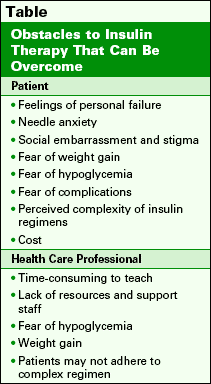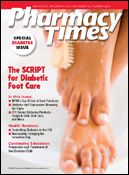Publication
Article
Pharmacy Times
Overcoming Barriers to Insulin Therapy
Author(s):
Pharmacists have an important role to play in dispelling myths about the use of insulin in effectively treating diabetes.
Mr. Meece is director of clinical services at Plaza Pharmacy and Wellness Center, Gainesville, Texas.
Editorial support was provided by Bioscript Stirling, with funding from Novo Nordisk.

Despite its potency in reducing A1C, insulin therapy continues to be underused for the treatment of type 2 diabetes in the United States, even though the emergence of several new insulin analogs and insulin delivery technologies has made insulin therapy safer, more effective, and more convenient than ever before.1 Part of the problem is that many patients and health care professionals alike cling to myths about insulin therapy that act as barriers to achieving recommended levels of glycemic control (Table).2,3
Many patients regard the need for insulin therapy as a personal failure to manage diabetes through diet, exercise, and other antidiabetic medications. Patients should be made aware that they may require insulin therapy as a consequence of the natural course of the disease and not a failure on their part. Patients also may recall relatives being placed on insulin late in the disease process, leaving them with an impression that insulin therapy is ineffective or that it causes complications, such as amputations or kidney failure.

Pharmacists should be aware of such cultural prejudices and explain that when complications occur, they are the result of a progressive disease that has long been uncontrolled and have nothing to do with the start of insulin therapy. Rather, insulin therapy actually helps to control blood sugar levels, reducing the risk of chronic complications.
Needle Anxiety
Patients may associate injections with those that they have received in the past for other purposes. Pharmacists can reassure patients by explaining that insulin injections now are relatively painless with smaller-diameter needles that are laser-sharpened and silicone-coated for ease of entry into the skin.4
Various injection aids may ease administration of insulin, as well as help reduce patient anxiety and perception of pain by concealing the needle.5 The Autoject 2, BD INJECTEASE Automatic Injector, Inject-Ease, and Instaject are spring-loaded, plastic syringe holders with push-button activation. The NovoPen 3 PenMate is an automatic injection attachment that fits the NovoPen Junior and NovoPen 3 pen devices. Pen needles, such as BD AutoShield Pen Needle and NovoFine Autocover, also conceal the needle while the injection takes place.
With the small number of patients who do exhibit true needle phobia, psychological counseling can be effective.
Weight Gain
Weight gain in patients who are already overweight or obese can lead to further insulin resistance and poor glycemic control. Maintaining metformin therapy while adding insulin-a combination that is recommended by the American Diabetes Association (ADA) treatment algorithm-attenuates weight gain.6 Dietary and exercise regimens also can help mitigate the anabolic effects of insulin on body weight. Referral to a dietitian can help the patient fully understand the relationship between insulin, carbohydrates, and food portions while improving nutrition. Recent research indicates that the basal insulin analog, insulin detemir (Levemir), is associated with less weight gain, compared with neutral protamine Hagedorn (NPH) insulin.7
Fear of Hypoglycemia
Fear of hypoglycemia is probably the main barrier encountered by health care professionals starting insulin therapy; however, the rate of severe hypoglycemia- episodes requiring medical intervention or the help of another individual- in patients with type 2 diabetes is relatively low, compared with the rate in type 1 diabetes.
Insulin analogs more closely mimic the actions of endogenous insulin than older insulin products, and thus help to decrease the incidence and severity of hypoglycemic events. Several studies have shown that insulin analogs-rapidacting and long-acting-are associated with less hypoglycemia than human insulin.8-10 The rapid-acting insulin analogs, insulin lispro (Humalog), insulin aspart (NovoLog), and insulin glulisine (Apidra), have a shorter time to peak effect and shorter duration of action than regular human insulin, resulting in less sustained insulin action between meals and thus a lower risk of hypoglycemia. Compared with NPH insulin, the long-acting insulin analogs, insulin glargine (Lantus) and insulin detemir (Levemir), have relatively flat time– action profiles and reduce the risk of nocturnal hypoglycemia.
Strategies for preventing hypoglycemia include understanding the relationship between carbohydrate content and insulin dose needed, understanding the time–action profile of insulin preparations, knowing when to inject and how to time meals and physical activity, and being aware of potential drug interactions, including the effects of alcohol.
Complexity of the Insulin Regimen
Both patients and health care providers may fear that adhering to a complex insulin regimen will be too difficult and time-consuming. Newer insulin regimens and pen devices decrease the complexity of insulin therapy, however. Several regimens for initiating insulin therapy in a systematic and effective manner are available and can be chosen according to the patient's preferences, needs, and abilities.
Regimens developed using premixed insulin analogs, such as insulin lispro 75/25 (Humalog Mix 75/25) or biphasic insulin aspart 70/30 (NovoLog Mix 70/30), provide a simple way to deliver both mealtime and basal insulin in one formulation. The 1-2-3 regimen, based on biphasic insulin aspart 70/30, starts with a single daily injection and adds further injections as needed.11 In the INITIATE study, a starting dose of biphasic insulin aspart 70/30 was used twice daily at 5 or 6 units, with adjustments made as needed until glycemic goals were met.12 If hypoglycemia occurs, the dose is decreased and the cause of the hypoglycemic event identified before any further dose increases are made.
Insulin Pen Devices
Various durable and prefilled disposable insulin pens are available that studies show demonstrate increased accuracy, efficacy, safety, patient preference, and improved adherence to therapy.13-16 These devices also allow for greater discretion, convenience, portability, and acceptance over the conventional vial and syringe. Pen needles are sharper than syringe needles, as they do not have to be inserted through the insulin vial stopper before injection, resulting in even less painful injections for the patient.
The NovoPen devices are reusable pens for use with the full Novo Nordisk range of human insulins (regular, NPH, and 70/30 formulations). FlexPens are disposable pens prefilled with insulin detemir, insulin aspart, or insulin aspart 70/30. Humulin pens are prefilled, disposable pens that contain 300 units of NPH Human Insulin Isophane Suspension (Humulin N) or human insulin 70/30 (Humulin 70/30). The Humalog family of insulin pens contains either 300 units of insulin lispro, insulin lispro mix 75/25, or insulin lispro mix 50/50.
HumaPen Memoir and HumaPen Luxura HD are reusable pens for use with insulin lispro. The Memoir features a digital display with memory that stores the date, time, and amount of the last 16 insulin doses, whereas the smaller Luxura HD delivers from 1 to 30 units of insulin in half-unit increments. OptiClik is a reusable pen for use with insulin glulisine or insulin glargine. The SoloSTAR pen is a disposable pen prefilled with insulin glargine and was approved in May 2007 for use in the United States. It allows for patients to administer up to 80 units of glargine in one injection. The Novolin InnoLet is an insulin doser that is prefilled with NPH Human Insulin Isophane Suspension (Novolin N) or Novolin 70/30 insulin and has a large dial with easy-to-read numbers for patients who have reduced manual dexterity or visual impairment.
Cost
Diabetes treatment can be expensive, especially for patients who have limited or no drug coverage. The ADA treatment algorithm recommends initiation or intensification of insulin therapy over the use of 3 oral agents, based on both effectiveness and cost.6 For many patients who have prescription cards with various copays, the amount saved by using insulin, compared with using 3 oral agents in combination, can be significant.
Future Trends
In addition to inhaled insulin formulations, various other noninvasive methods of insulin are being explored, which may eventually provide further options for patients who are unable or unwilling to take insulin by injection.16
Although these may help to increase adherence once they are developed and perfected, the greatest tool to improved adherence and earlier initiation of insulin will be good communication between the pharmacist and the patient.
References
- Riddle MC. The underuse of insulin therapy in North America. Diabetes Metab Res Rev. 2002;(suppl 3):S42-49.
- Peyrot M, Rubin RR, Lauritzen T, et al. Resistance to insulin therapy among patients and providers: results of the cross-national Diabetes Attitudes, Wishes, and Needs (DAWN) study. Diabetes Care. 2005;28:2673-2679.
- Polonsky WH, Fisher L, Guzman S, Villa-Caballero L, Edelman SV. Psychological insulin resistance in patients with type 2 diabetes: the scope of the problem. Diabetes Care. 2005;28:2543-2545.
- Graff MR, McClanahan MA. Assessment by patients with diabetes mellitus of two insulin pen delivery systems versus a vial and syringe. Clin Ther. 1998;20:486-496.
- Diglas J, Feinbock C, Winkler F, et al. Reduced pain perception with Pen Mate, an automatic needle insertion device for use with an insulin pen. Practical Diabetes Int. 1999;16(2):39-41.
- American Diabetes Association. Standards of medical care in diabetes-2007. Diabetes Care. 2007;30(suppl 1):S4-S41.
- Peterson GE. Intermediate and long-acting insulins: a review of NPH insulin, insulin glargine and insulin detemir. Curr Med Res Opin. 2006;22:2613-2619.
- Riddle MC, Rosenstock J, Gerich J; Insulin Glargine 4002 Study Investigators. The treat-to-target trial: randomized addition of glargine or human NPH insulin to oral therapy of type 2 diabetic patients. Diabetes Care. 2003;26:3080-3086.
- Boehm BO, Vaz JA, Brondsted L, Home PD. Long-term efficacy and safety of biphasic insulin aspart in patients with type 2 diabetes. Eur J Intern Med. 2004;15(8):496-502.
- Kilo C, Mezitis N, Jain R, Mersey J, McGill J, Raskin P. Starting patients with type 2 diabetes on insulin therapy using once-daily injections of biphasic insulin aspart 70/30, biphasic human insulin 70/30, or NPH insulin in combination with metformin. J Diabetes Complications. 2003;17(6):307-313.
- Garber AJ, Wahlen J, Wahl T, et al. Attainment of glycaemic goals in type 2 diabetes with once-, twice-, or thrice-daily dosing with biphasic insulin aspart 70/30 (The 1-2-3 study). Diabetes Obes Metab. 2006 Jan;8:58-66.
- Raskin P, Allen E, Hollander P, et al. Initiating insulin therapy in type 2 Diabetes: a comparison of biphasic and basal insulin analogs. Diabetes Care. 2005;28:260-265.
- Korytkowski M, Bell D, Jacobsen C, Suwannasari R. A multicenter, randomized, open-label, comparative, two-period crossover trial of preference, efficacy, and safety profiles of a prefilled, disposable pen and conventional vial/syringe for insulin injection in patients with type 1 or 2 diabetes mellitus. Clin Ther. 2003;(11):2836-2848.
- Niskanen L, Jensen LE, Rastam J, Nygaard-Pedersen L, Erichsen K, Vora JP. Randomized, multinational, open-label, 2-period, crossover comparison of biphasic insulin aspart 30 and biphasic insulin lispro 25 and pen devices in adult patients with type 2 diabetes mellitus. Clin Ther. 2004;26:531-540.
- Koenigsberg MR, Bartlett D, Cramer JS. Facilitating treatment adherence with lifestyle changes in diabetes. Am Fam Physician. 2004;69:309-16.
- Cefalu WT. Concept, strategies, and feasibility of noninvasive insulin delivery. Diabetes Care. 2004;27:239-246.

Newsletter
Stay informed on drug updates, treatment guidelines, and pharmacy practice trends—subscribe to Pharmacy Times for weekly clinical insights.






